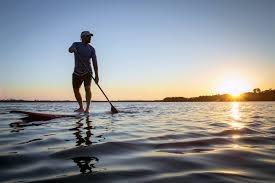Top Tips for Beginners
Purchasing a Board
When diving into the stand-up paddle boarding (SUP) world, you’ll encounter two main types of boards: inflatable and hard. This guide focuses on inflatable paddle board, also known as iSUPs. The vast array of choices can be overwhelming, but here’s what you must consider when buying your first board.
Avoid the Cheapest Boards: It might be tempting to browse online marketplaces for the most budget-friendly option, but the cheapest boards often are poor quality. These typically feature single-layer PVC construction, which is more prone to punctures. If possible, opt for a double-layer PVC board for better durability and longevity.
PSI Rating: Look for a board with a recommended PSI (pounds per square inch) of at least 15. Higher PSI ratings indicate greater rigidity and stability. Boards that can be inflated to 20+ PSI are particularly stable and provide a better experience.
Beginner Boards – Size and Shape
For those new to paddle boarding, stability is key. Beginner boards, often labeled as “entry-level” or “all-rounders,” are designed to offer this stability.
Typical Dimensions for Beginners:
- Width: Approximately 32 inches
- Depth: 6 inches
- Length: 10’6”
Weight Consideration: Ensure the board’s recommended rider weight aligns with your weight. This information is crucial for maintaining balance and control of the water.
Budget: A reasonable budget for a good quality beginner board ranges from £400-£900. This price range generally ensures you’re buying from a reputable manufacturer.
Touring Boards – Growing Into Your Hobby
Once you’ve gained some experience, you might consider upgrading to a touring board. These boards are designed for longer trips and have a more streamlined shape for efficient gliding. Touring boards typically start at 12’6” in length and feature a different fin design for improved performance.
What’s Included?
When purchasing a paddle board, expect to receive the following:
- Paddleboard
- Paddle
- Ankle leash
- Manual hand pump
- Fin
- Repair kit
- Carry bag
- Carry strap
Quality Considerations: At the lower end of the budget spectrum, some compromises might be necessary. For instance, paddles made of aluminum are common but may not float if dropped in water. Investing in a fiberglass or carbon fiber paddle can be worthwhile. Additionally, ensure the repair kit includes patches, glue, and a valve tool.
Worthwhile Extras
To enhance your paddle-boarding experience, consider these additional items:
- Upgraded paddle
- First aid kit
- GoPro mount
- Decent dry bag
- Waterproof phone case
- Comprehensive repair kit with glue and valve tool
- The quick-release belt for fast-flowing water
- Dry suit for winter paddling
Using Your Leash
Leashes come in different types (ankle, calf, and waist), each suited for specific conditions. It’s essential to understand the differences and choose the right one for your needs.
Pumping Up Your Board
A common concern among beginners is the apparent slow increase in PSI while inflating the board. Patience is crucial, as it takes time and effort. If manually pumping is too strenuous, consider an electric pump. Always ensure you inflate to the recommended PSI for optimal stability.
Top Tip: Ensure the valve is in the upright position when connecting your pump. If it’s not, air will escape as soon as you remove the pump.
Conclusion
Purchasing your first inflatable paddle board involves considering several factors to ensure you get the best experience. Start with a stable, beginner-friendly board, and as you gain confidence and skills, you can explore more specialized options like touring boards or even an inflatable foil board for advanced performance. Equip yourself with the necessary accessories and knowledge to make the most of your paddle-boarding adventures. Enjoy the journey on the water!



